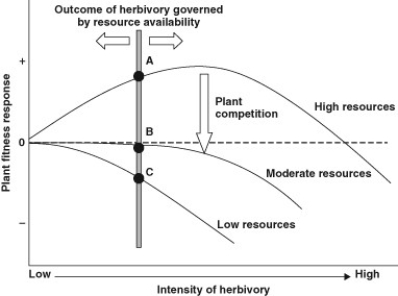Multiple Choice
Use the figure to answer the following question.
The figure proposes a combination of a top-down and bottom-up model (a hypothesis) to describe the variable effects of biological control herbivores on the fitness (growth and reproduction) of an invasive, non-native plant, spotted knapweed (Centaurea stoebe) . These herbivores include multiple insects that were first studied in the plant's native home range in eastern Europe, where the plant is not dominant in grassland communities and does not pose a problem to land managers and conservationists. Many insects there were found to consume the plant's tissues, including stems, leaves, and seeds, and some were very host specific and were not found to attack plants other than C. stoebe. Several insects were subsequently transported and released in an attempt to reduce densities of this non-native and problematic weed in the United States. The y-axis shows C. stoebe plant fitness, and the x-axis represents the intensity of herbivory by the insects, from low to high. As the vertical shaded bar is moved along the x-axis, the ultimate effect of herbivory (now A, B, andC) on plant fitness can change based on its intensity and also may depend on the other factors. The horizontal dashed line represents no predicted change in fitness under the effects of varying intensity of herbivory, plant competition, and soil resources available to the plant (such as nitrogen or water) , while the three solid lines represent other possible outcomes.
(D) G. Knochel and T.R. Seastedt. 2011. Reconciling contradictory findings of herbivore impacts on spotted knapweed (Centaurea stoebe) growth and reproduction. Ecological Applications 20(7) :1903-1912.
What portion of the model would be characterized as bottom-up?
A) plant fitness
B) resources available to the plant
C) intensity of herbivory on the plant
D) plant competition and fitness
Correct Answer:

Verified
Correct Answer:
Verified
Q1: Character displacement differs from resource partitioning because
Q3: Use the graph to answer the following
Q4: Bouchard and Brooks studied the effect of
Q6: Use the following diagram of five islands
Q10: Why is a pathogen generally more virulent
Q11: The oak tree fungal pathogen, Phytophthora ramorum,
Q12: Use the figures to answer the following
Q22: Which of the following is a widely
Q38: Which of the following best describes the
Q45: Based on the intermediate disturbance hypothesis, a